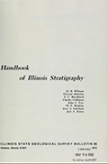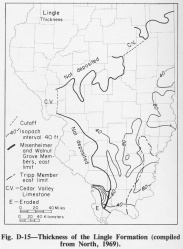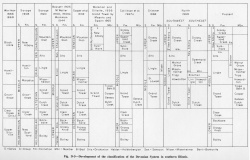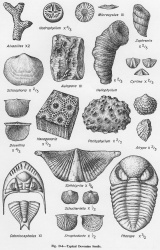Historical:Lingle Formation
Lithostratigraphy: Hunton Limestone Megagroup >>Lingle Formation
Chronostratigraphy: Paleozoic Erathem >>Devonian System >>Middle Devonian Series
Allostratigraphy: Kaskaskia Sequence
Authors
Charles Collinson and Elwood Atherton
Name Origin
The Lingle Formation (Savage, 1920, p. 171, 176; Weller, 1944a, p. 95-96; North, 1969, p. 14-22) is named for Lingle Creek in southern Union County.
Type Section
The type section of the Lingle Formation is a poorly exposed outcrop on a branch of Lingle Creek (SE SW SW 26, 13S-2W). A more complete exposure occurs 3.25 miles west of Cobden, Union County (NW NE 34, 11 S-2W).
Correlation
Faunal evidence relate the Lingle to the upper half of the Hamilton in New York (Collinson et al., 1967a).
Extent and Thickness
The Lingle occurs throughout a large area south of the Sangamon Arch, generally overlapping the Grand Tower (fig. D-15), and it has a maximum thickness of about 110 feet.
Description
Because the sequence is complex and the exposures poor and widely scattered (Weller, 1940), the Lingle has been variously interpreted (fig. D-5). Savage (1920) differentiated a shale at the base- the Misenheimer Shale- as a separate formation, but Weller (1944a) included the shale in the Lingle and abandoned the name "Misenheimer." Grimmer (1968) and North (1969) related the type Misenheimer to a shale well above the base of the Lingle and reinstated Misenheimer but made it a member of the Lingle. The Lingle Formation is an interval of mixed limestone and shale. It is more argillaceous, more shaly, darker colored, and finer grained than the Grand Tower below, and less silty and dolomitic than the Alto Formation above. North (1969) subdivided the Lingle into the Howardton Limestone Member (argillaceous, shaly) at the base, the Tripp Limestone Member (argillaceous, silty, cherty), the Misenheimer Shale Member, and the Walnut Grove Limestone Member (cherty, very silty, glauconitic) at the top. The Walnut Grove is characterized by the Rendleman Oolite Bed near its base. Of the four members, the Misenheimer and Walnut Grove occur only near the outcrop area in southwestern Illinois (fig. D-15). North interpreted these two members and the more extensive Tripp Member below as grading laterally eastward into the New Albany Shale Group, with the Tripp Member essentially equivalent to the Blocher Shale. However, the relations are not clearly demonstrable, and faunal evidence suggests that all three members plus the overlying Alto and Sylamore Formations may be equivalent to the Blocher.
Fossils
Some of the Lingle strata are very fossiliferous, and both macrofossils (Savage, 1920; Grimmer, 1968) and conodont faunas (Orr, 1964) have been described. Characteristic fossils include Microcyclus discus (fig. D-6), Devonochonetes coronatus, and Mucrospirifer mucronatus.
References
COLLINSON, CHARLES, L. E. BECKER, G. W. JAMES, J. W. KOENIG, and D. H. SWANN, 1967a, Illinois Basin, in International symposium on the Devonian System: Alberta Society of Petroleum Geologists, v. 1, p. 940-962; Illinois State Geological Survey Reprint 1968-G.
GRIMMER, J. C., 1968, Stratigraphy of the Middle Devonian shales of southern Illinois: Illinois Academy of Science Transactions, v. 61, p. 407-415.
NORTH, W. G., 1969, Middle Devonian strata of southern Illinois: Illinois State Geological Survey Circular 441, 45 p.
ORR, R. W., 1964, Conodonts from the Devonian Lingle and Alto Formations of southern Illinois: Illinois State Geological Survey Circular 361, 28 p.
SAVAGE, T. E., 1920, Devonian formations of Illinois: American Journal of Science, v. 49, p. 169-182.
WELLER, J. M., 1940, Geology and oil possibilities of extreme southern Illinois: Illinois State Geological Survey Report of Investigations 71, 71 p.
WELLER, J. M., 1944a, Devonian System in southern Illinois: Illinois State Geological Survey Bulletin 68, p. 89-102.
ISGS Codes
| Stratigraphic Code | Geo Unit Designation |
|---|---|



